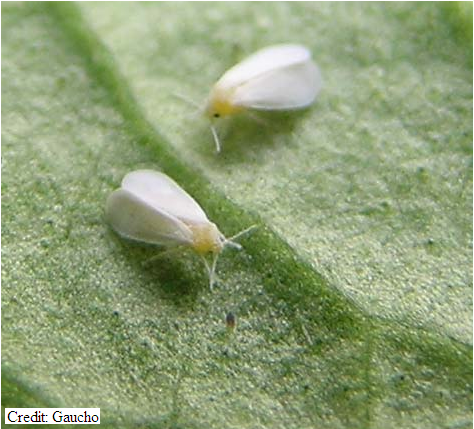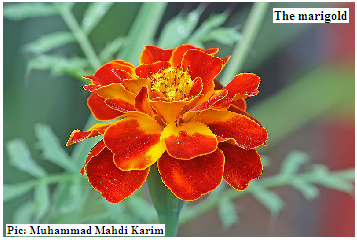Foliage that repels pests can be a useful companion of food plants, says S.Ananthanarayanan.
Large scale cultivation of food plants, especially of single varieties, leads to rapid increase of pest population. The farmer is forced to use pesticides, which is a cost, and has its downside. Apart from being a pollutant, chemical pesticides harm useful organisms in the soil and on plants, including the plants’ natural protection against pests. And even against the pests, they become progressively less effective.
A group of environment scientists in the UK takes note of an old gardeners’ practice, of letting French marigolds flower along with tomato bushes, to protect the food plant from the Glasshouse Whitefly, an important pest that affects tomatoes. In a paper in the journal, PLOS ONE, Niall J.A. Conboy, Thomas McDaniel, Adam Ormerod, David George, Angharad M.R. Gatehouse, Ellie Wharton, Paul Donohoe, Rhiannon Curtis, Colin R. Tosh, from the Newcastle and Northumbria Universities and Stockbridge Technology Centre, North Yorkshire, describe their studies to track down how this device, of planting marigold, works, to see if it could be harnessed to help tomato production, and crop protection in general.
The Glasshouse Whitefly is a small, moth-like insect that lays eggs on the underside of the leaves of many vegetable and other crop plants. When the eggs hatch, the Whitefly larvae, and even later stages of insect development, consume the plant fluids and material by penetrating leaf veins to reach the sap. This apart, the sugary ‘honeydew that they excrete sustains fungal growths and blocks photosynthesis. And then, the adult insects transmit viral infections.

The study by the scientists, which was to establish the protective effect of the marigold and other plants, was carried out with different timing and mix of protection. One was to introduce marigold, and then to add other, Whitefly-repelling species, along with tomato plants right from the start. And the protective effect was compared against a control group. Another trial was to introduce the marigold plants later in the season, after a viable Whitefly population had collected, to see if the farmer could take recourse to marigold not as a preventive, but when she finds that Whitefly started getting active. The third trial was to see if the opposite approach, of planting Whitefly attracting hosts in the periphery of the tomato patch, to draw the Whitefly away, brought about an improvement.
The studies showed that the presence of marigold plants had a definite effect of keeping the Whitefly away, most effectively when used from the start, with lesser improvements when combined with other pest-repellent species, and scarcely any when pests were drawn away by competing hosts in the periphery. And the agent that brought about the effect was isolated as limonene, a volatile substance that is found in the skin of citrus fruit and was a large part of the substances exuded by the marigold plant.

Trials were then conducted by placing, not marigolds, but limonene dispensers in the tomato beds. As limonene was the operative agent in marigolds, the dispensers did prove effective in keeping the Whitefly away. And in the case of ‘emergency’, use, which is when pressed into use only after Whitefly have multiplied to good numbers, the dispensers were found to be more effective than planting marigolds. The paper notes that optimum strategies for deploying marigold plants as well as limonene dispensers need to be developed
Along with marigold, there are other plants that repel, both the Whitefly as well as other pests that farmers need to control. A viable bouquet of plants and dispensers of the plant volatiles could hence take the place of chemical pesticides, to great advantage. First, of course, is the saving of cost, the energy used in production of pesticides and the pollution that pesticides cause in soil, in run-off water and in the vegetable product. The next is the advantage that comes from biodiversity. And finally that pests would not develop resistance, which they do with insecticides.
The mechanism of resistance is that when an organism is killed by the intervention, the occasional mutant individuals in the population that are immune get a survival advantage. These numbers then proliferate, and in a few generations the whole population consists of resistant insects. When the method of pest control is to repel, rather than eliminate the pest species, individuals that are not repelled do have the advantage in foraging and breeding, but others only move away, they do not die out. ‘Resistant’ individuals hence do not dominate and cannot overwhelm the others to the extent that we speak of a resistant strain having arisen.
In the year 2015, researchers based in Sweden and Mexico City had described in the journal, Trends in Plant Science, a method of interspersing crop plants with other plants that react to pests by releasing volatile substances that attract the predators of the pest species. Wild plants, they said, often generated volatile organic compounds (VOC), which produce odours, to announce that leaf-eating organisms, which endanger plants, have appeared on the scene. An example is the smell, that all of us would be familiar with, which comes from the damage to grass when a lawn is being mown. VOCs released are of different kinds and can indicate the nature of damage. In the case of attack by herbivores, the VOCs could alert the specific predators of the herbivore involved.
Many such traits, which confer direct resistance to pests, the Mexico City paper says, have been counter-selected during domestication, because they depend on undesirable properties such as bitterness, hairiness, toughness, or toxicity, and thus reduce the quality of the consumed parts. Another reason for breeding them out could be that expression of the resistance, in the form of VOC, for instance, consumes resources and reduces the yield of the crop. This may be the same with vegetable plants and means of repelling pests like the Whitefly and the tomato plant
The paper in PLOS ONE also says that if the plants that help crop plants, like the tomato, could be bred to have economic value, like being edible or ornamental, this would make them attractive to growers, with overall benefit to society and the environment.
------------------------------------------------------------------------------------------ Do respond to : response@simplescience.in-------------------------------------------